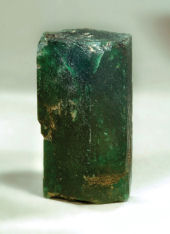Zambia: The Emerald Country
May 31, 07
Zambia is best known for its emerald deposits. For many years, the mines in the area adjacent to the Kafubu River, in the Ndola Rural Restricted Area some 45 kilometers from the town of Kitwe, have produced the bulk of the country’s emeralds—goods that found their way into the calibrated emerald market. 
While emeralds were already mined on a small scale in the 1930s, mining of emerald in the Kafubu area only became significant in the 1970s. As the government recognized its economic potential and the danger of illegal mining, it established a restricted zone and forced the inhabitants to move out.
Between 1980 and 2001, a government agency, the Reserved Minerals Corporation (RMC), managed the prospecting and mining rights and held a 55 percent stake in a mining company called Kagem, with the other 45 percent held by Hagura, an Indian-Israeli cooperative. Kagem was privatized in 2001, with Hagura buying up the government’s shares. In a landmark article Emeralds from the Kafubu Area, Zambia published in the summer 2005 issue of GIA’s Gems and Gemology, the authors noted that apart from the Kagem properties - the Kagem, Grizzly and Chantete concessions - another 500 claims are actively worked by artisanal miners.
While in the 1980s annual exports exceeded the $100 million mark, currently official Zambian emerald exports stand at $20 million annually. However, since smuggling remains an important and significant factor, it is safe to assume that the value of emeralds exiting the country is at least double the official count. Most of the rough, which is sold at official tenders and on the open market, winds up in India or Israel; the former getting the bulk of the goods by volume, and the latter concentrating on those of high value. Even at the current level, Zambian emeralds are 20 percent of the world supply and are much sought after because of their unique deep green color.
Elsewhere in Zambia, opportunities are available for investors interested in the mining and processing of precious stones such as amethyst, of which the country boasts the largest deposits in Africa, producing an estimated 700 tons of material annually. There are also modest deposits of tourmaline, including bright yellow “canary” tourmaline, spessartite garnet and aquamarine. Alluvial diamonds have been discovered in the Western and Northern Provinces, opening yet another great opportunity for exploration. The Chimwadzulu Hill deposit promises future potential for sapphire and ruby production.
A World Bank report estimates that Zambia could reap as much as $830 million a year from its gemstones. Current annual recorded sales are only in the $20 million range. There have been many attempts to correct this situation; the Zambian Mining Sector Diversification Program, which began in 2002, is running as a five-year project of the Ministry of Mines and Mineral Development, with the financial support of the European Development Fund.
Article reproduced courtesy of the International Colored Gemstone Association (ICA).